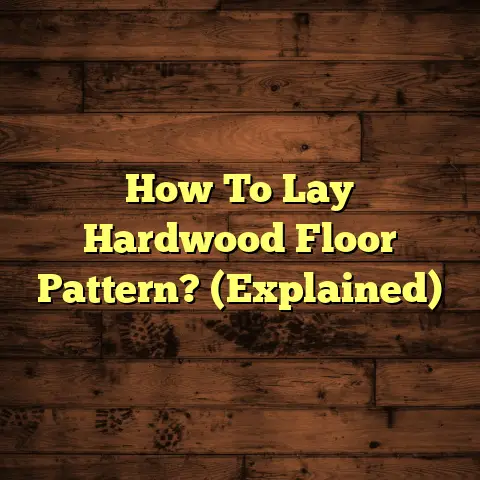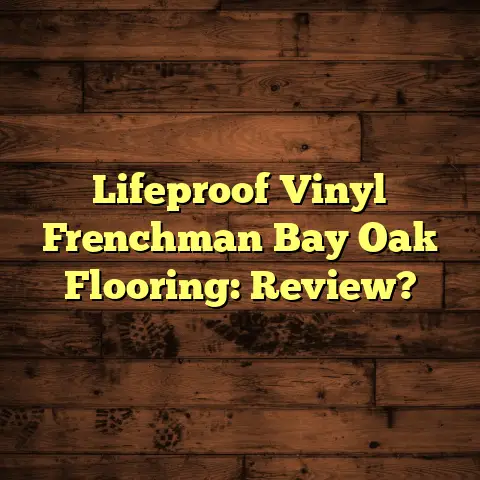Non-Slip Tiles in Australia? (5 Key Ratings!)
Have you ever had that heart-stopping moment where your feet went out from under you on a wet tile floor? I know I have.
It was a few years back, and my daughter was running through the kitchen after coming in from the pool. Next thing you know, bam! She was down. Thankfully, it was just a bump and a few tears, but it could have been so much worse.
That incident really opened my eyes to how dangerous slippery floors can be, especially in areas like kitchens, bathrooms, and around pools. It got me thinking: how can we make our homes both stylish and safe?
The answer, my friend, lies in understanding non-slip tiles. Let’s dive in!
Section 1: Understanding Non-Slip Tiles
So, what exactly are non-slip tiles?
Simply put, they’re tiles designed to provide better grip than standard tiles, reducing the risk of slips and falls. The key difference lies in their surface texture and composition.
Standard tiles often have a smooth, polished surface, which looks great but can become treacherous when wet. Non-slip tiles, on the other hand, feature textured surfaces, like a slightly rough or dimpled finish, that increases friction.
The Secret Sauce: Slip Resistance Ratings
Now, here’s where it gets a bit technical. The slip resistance of a tile is measured using specific tests and standards.
In Australia, we primarily refer to the AS 4586 standard for slip resistance classification. This standard outlines various test methods, including the wet pendulum test and the oil-wet ramp test, to determine a tile’s slip resistance rating.
Think of it like this: the higher the rating, the better the grip.
Material Matters: What Are They Made Of?
Non-slip tiles come in a variety of materials, each with its own pros and cons:
-
Ceramic: Affordable and versatile, ceramic tiles are a popular choice for many areas of the home. They can be treated to increase their slip resistance.
-
Porcelain: Denser and more durable than ceramic, porcelain tiles are ideal for high-traffic areas and outdoor use. Many porcelain tiles are naturally slip-resistant.
-
Natural Stone: Materials like slate and sandstone offer natural texture and excellent slip resistance. However, they can be more expensive and require more maintenance.
-
Quarry Tile: These are unglazed tiles that are known for their durability and natural slip resistance. They’re often used in commercial kitchens and industrial settings.
Section 2: The Importance of Non-Slip Ratings
Let’s get real for a second. Why are these ratings so important?
Well, consider this: According to Safe Work Australia, slips, trips, and falls are a leading cause of injury in Australian workplaces and homes.
While specific statistics on home-related slip injuries are harder to pin down, I can tell you from my experience as a flooring contractor that I’ve seen firsthand the devastating consequences of these accidents.
A simple slip can lead to fractures, sprains, head injuries, and even long-term disabilities. And it’s not just the elderly who are at risk; people of all ages can be affected.
Understanding the Rating Scales
The AS 4586 standard uses several rating scales to classify slip resistance. The most common ones you’ll encounter are the R ratings (R9 to R13) and the Pendulum Test Value (PTV).
-
R Ratings (R9 to R13): This scale measures the slip resistance of a tile when walked on with shoes. The higher the number, the greater the slip resistance.
-
Pendulum Test Value (PTV): This test simulates the slip resistance of a tile when walked on with both shoes and bare feet. A higher PTV indicates better slip resistance.
Here’s a quick breakdown of what each R rating generally means:
- R9: Suitable for dry areas with low foot traffic.
- R10: Good for bathrooms and kitchens.
- R11: Recommended for commercial kitchens, public restrooms, and pool areas.
- R12 & R13: Ideal for demanding environments, like industrial settings and outdoor ramps.
Section 3: The 5 Key Ratings of Non-Slip Tiles
Alright, let’s get down to the nitty-gritty. We’re going to explore the 5 key R ratings you need to know when choosing non-slip tiles for your home.
1. R9 Rating
R9 rated tiles are your entry-level non-slip option. They offer a slight improvement in slip resistance compared to standard tiles but are best suited for dry areas with minimal foot traffic.
Typical Uses and Environments:
- Residential bathrooms (dry areas only)
- Kitchens (away from sink and cooking areas)
- Living rooms
- Bedrooms
Suitable Applications:
I often recommend R9 tiles for homeowners who want a slightly safer option in low-risk areas. For example, you might use R9 tiles in a guest bathroom that doesn’t get a lot of use or in a kitchen area away from the sink and stovetop.
Think of it this way: R9 tiles are a good starting point, but they’re not a one-size-fits-all solution.
2. R10 Rating
Now we’re talking! R10 rated tiles offer a noticeable improvement in slip resistance and are a great choice for areas that may occasionally get wet.
Characteristics:
- Slightly textured surface
- Good grip when wet
- Durable and easy to clean
Recommended Usage:
- Residential bathrooms (including shower areas)
- Kitchens (around sinks and stovetops)
- Laundry rooms
- Covered patios
Advantages:
I find R10 tiles to be a sweet spot for many homeowners. They provide a good balance between safety, aesthetics, and affordability. They’re durable enough to withstand daily wear and tear, easy to clean, and come in a wide range of styles.
Real-World Example:
I recently helped a client renovate their bathroom, and they were concerned about slip resistance in the shower area. We went with R10 rated porcelain tiles, and they were thrilled with the result. The tiles looked great, and they felt much safer showering.
3. R11 Rating
When things get seriously wet, you need R11 rated tiles. These tiles are designed for areas that are frequently exposed to water and require a high level of slip resistance.
Properties:
- More textured surface than R10 tiles
- Excellent grip in wet conditions
- Suitable for heavy foot traffic
Examples of Installation Areas:
- Commercial kitchens
- Public restrooms
- Pool areas
- Outdoor walkways
- Change rooms
Why Choose R11?
If you have a pool area, a commercial kitchen, or any other space where water is constantly present, R11 tiles are a must. They provide the peace of mind that you and others won’t easily slip and fall.
Personal Experience:
I once worked on a project for a local swimming pool, and we used R11 rated tiles around the pool deck and in the change rooms. The pool management team was extremely happy with the increased safety the tiles provided.
4. R12 Rating
R12 rated tiles are the heavy-duty champions of slip resistance. They’re designed for areas that not only get wet but also experience high traffic and require exceptional grip.
Characteristics:
- Aggressively textured surface
- Superior slip resistance in wet and oily conditions
- Durable and long-lasting
Suitability:
- Industrial kitchens
- Food processing plants
- Ramps and loading docks
- Commercial garages
Balancing Aesthetics and Safety:
While R12 tiles prioritize safety above all else, manufacturers are now offering a wider range of designs and colors to choose from. You can find R12 tiles that are both functional and visually appealing.
Pro Tip:
When selecting R12 tiles, be sure to consider the cleaning requirements. The highly textured surface can trap dirt and grime, so you’ll need to use appropriate cleaning products and methods.
5. R13 Rating
At the pinnacle of slip resistance, we have R13 rated tiles. These tiles are engineered for the most demanding environments where safety is paramount.
Applications:
- Extreme industrial settings
- Oil rigs
- Sloped walkways
- Areas with constant exposure to water, oil, and other contaminants
Superior Slip Resistance:
R13 tiles feature an extremely rough surface that provides unparalleled grip, even in the most challenging conditions.
Stylish and Safe:
While R13 tiles are primarily used in commercial and industrial settings, some homeowners are opting for them in outdoor areas with steep slopes or in areas prone to extreme weather conditions.
Important Note:
R13 tiles are typically more expensive than other non-slip options, and their aggressive texture may not be suitable for all applications. However, if you need the highest level of slip resistance, they’re the way to go.
Section 4: Comparing Non-Slip Tile Options in Australia
Alright, now that you know about the different R ratings, let’s talk about some specific brands and products available here in Australia.
Popular Brands:
-
Johnson Tiles: A well-known brand offering a wide range of non-slip tiles in various materials and styles.
-
Beaumont Tiles: One of Australia’s largest tile retailers, with a diverse selection of non-slip options.
-
TileCloud: An online retailer offering a curated collection of stylish and functional non-slip tiles.
Expert Insights:
I recently spoke with a representative from Johnson Tiles, and they emphasized the importance of considering the specific application when choosing non-slip tiles.
“It’s not just about the R rating,” they said. “You also need to think about the type of traffic, the potential for spills, and the overall aesthetic you’re trying to achieve.”
Regional Differences:
In coastal areas, where moisture and humidity are prevalent, I often recommend higher R ratings (R11 or R12) for outdoor spaces. In drier inland regions, R10 tiles may be sufficient for most applications.
Here’s a quick comparison table to help you narrow down your choices:
| Feature | R9 | R10 | R11 | R12 | R13 |
|---|---|---|---|---|---|
| Slip Resistance | Low | Medium | High | Very High | Extreme |
| Typical Use | Dry Areas | Bathrooms, Kitchens | Pools, Commercial | Industrial | Extreme Conditions |
| Price | Affordable | Moderate | Higher | Expensive | Very Expensive |
| Maintenance | Easy | Easy | Moderate | Moderate to High | High |
| Aesthetics | Wide Variety | Good Variety | Limited Variety | Limited Variety | Very Limited |
Section 5: Real-Life Applications and Case Studies
Let’s bring this all together with some real-life examples of how non-slip tiles have made a difference in Australian homes.
Case Study 1: The Family Bathroom
I worked with a family who had young children and were concerned about slips and falls in their bathroom. We replaced their old, slippery tiles with R10 rated porcelain tiles with a subtle textured finish.
The result was a safer and more stylish bathroom that the whole family could enjoy. The parents were thrilled with the peace of mind knowing that their kids were less likely to slip and fall.
Case Study 2: The Outdoor Entertainment Area
Another client had a beautiful outdoor entertainment area with a pool, but the existing tiles were incredibly slippery when wet. We installed R11 rated natural stone tiles with a honed finish.
The transformation was remarkable. The new tiles not only looked fantastic but also provided excellent grip, even when the area was soaked.
Testimonials:
- “I used to worry every time my kids ran around the pool, but now I feel so much safer knowing that we have non-slip tiles.” – Sarah, Sydney
- “Our new bathroom is not only beautiful but also much more functional. The non-slip tiles have made a huge difference.” – Michael, Melbourne
Conclusion
Choosing the right non-slip tiles is an investment in the safety and well-being of your family. By understanding the different R ratings and considering your specific needs, you can create a home that is both stylish and safe.
Don’t wait until an accident happens to take action. Take the time to research your options, consult with a flooring professional, and choose the non-slip tiles that are right for you.
Remember, your home should be a place of comfort and security, not a potential hazard. With the right flooring choices, you can create a space where you and your loved ones can thrive.





